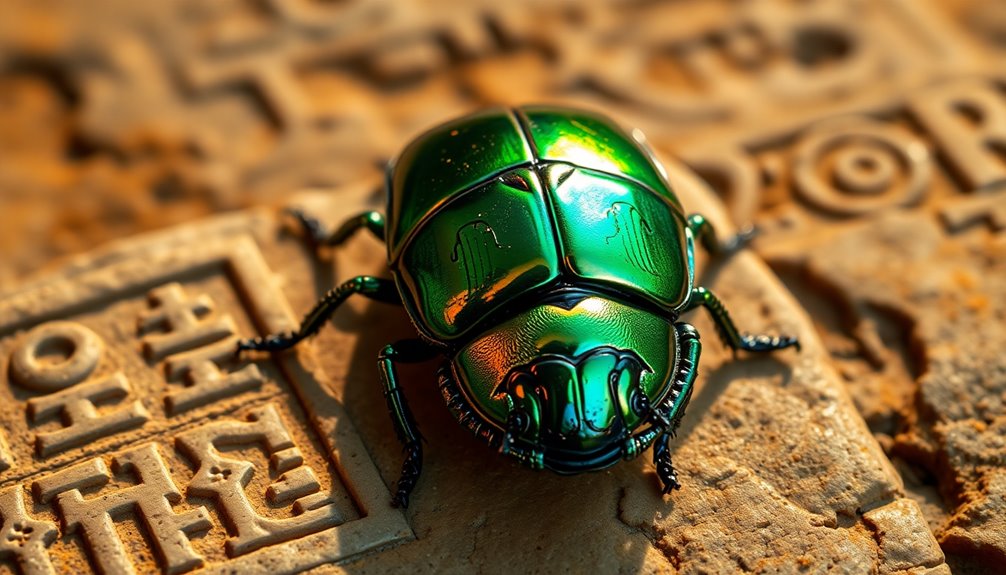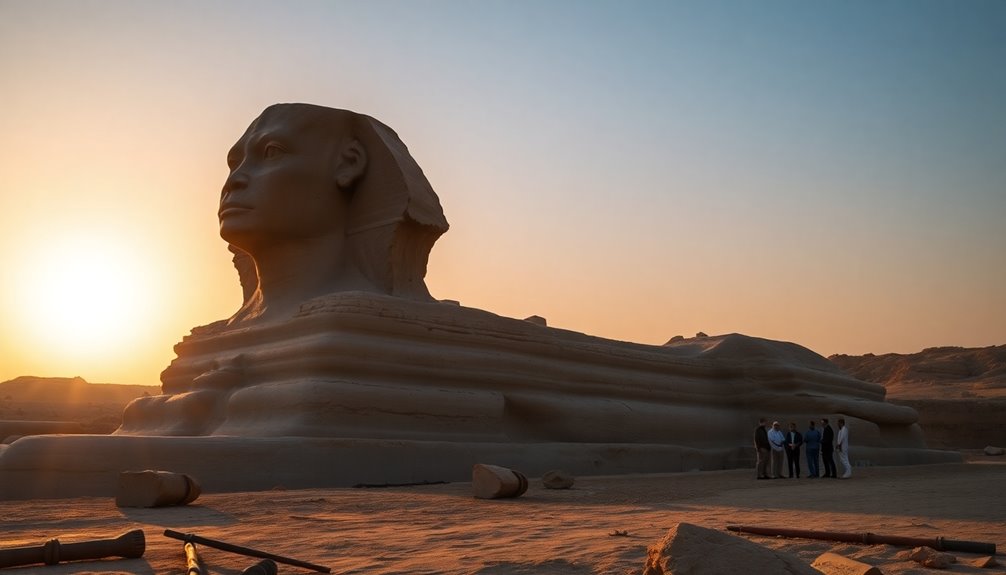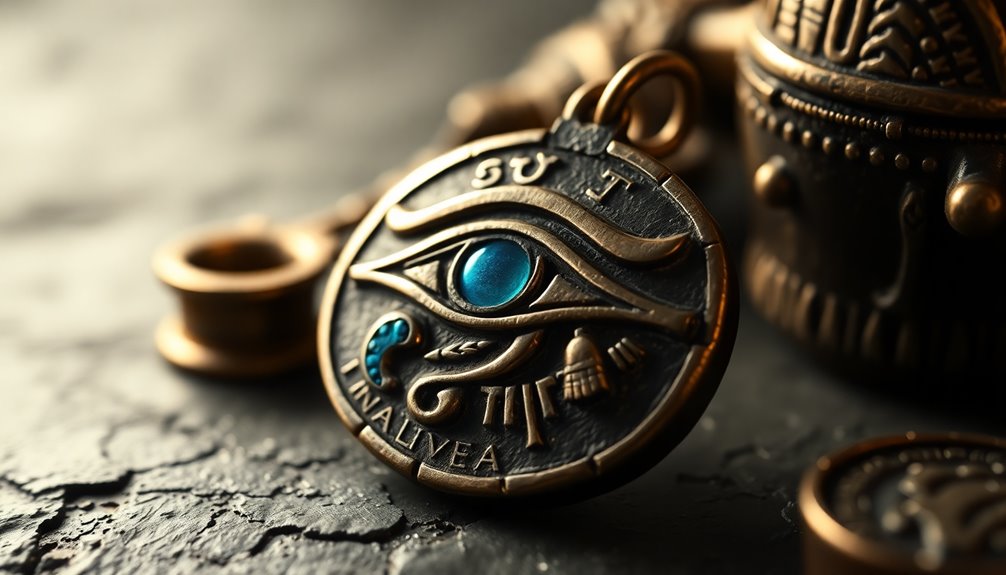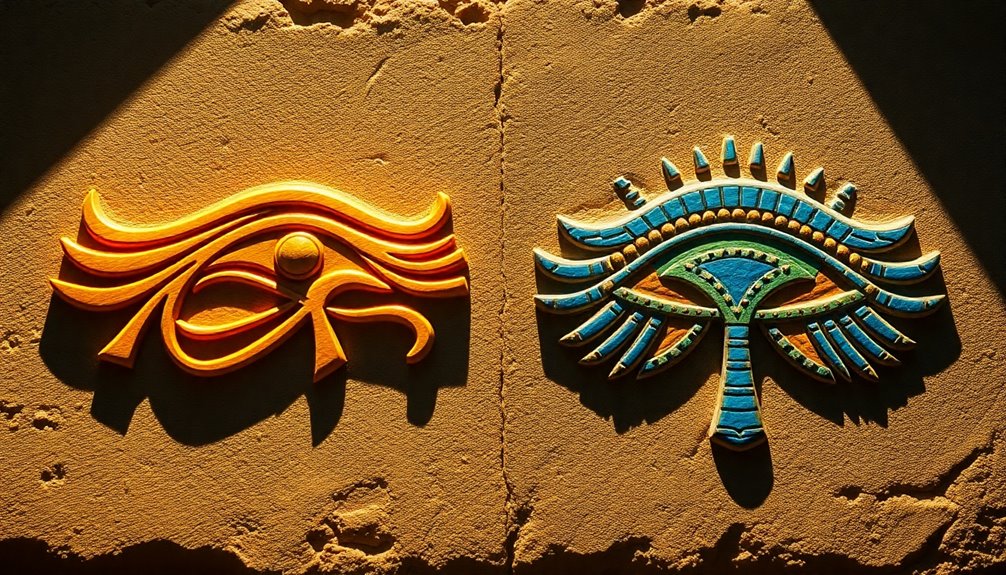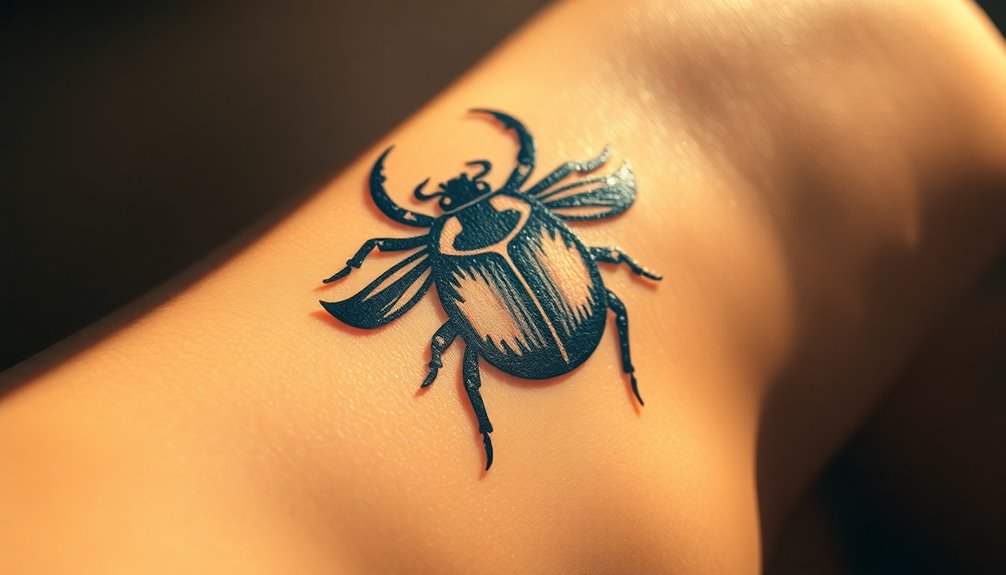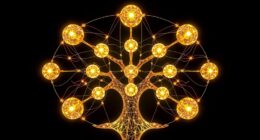The scarab stands as a powerful symbol of life, protection, and transformation. In ancient Egypt, it represented the cycle of life and rebirth, reflecting the eternal journey of the sun god Khepri. Scarabs were often fashioned into amulets, believed to guard against evil and misfortune, emphasizing their protective nature. They've influenced art and modern fashion, embodying themes of personal growth and resilience. Furthermore, their legacy inspires environmental awareness, urging respect for nature's cycles. This timeless icon continues to resonate, offering insights into both ancient beliefs and contemporary values. Discover the deeper meanings behind this fascinating symbol.
Key Takeaways
- Scarabs symbolize life, death, and regeneration, reflecting the eternal cycle central to ancient Egyptian beliefs.
- The scarab's connection to Khepri represents daily rebirth and the transformative power of the sun.
- Scarab amulets offered protection against evil and misfortune, enhancing spiritual safety in life and afterlife.
- Artistic representations of scarabs in jewelry and sculptures showcase their cultural significance and craftsmanship throughout history.
- Scarabs inspire modern environmental awareness, highlighting the interconnectedness of life and the importance of ecological balance.
Historical Significance of Scarabs
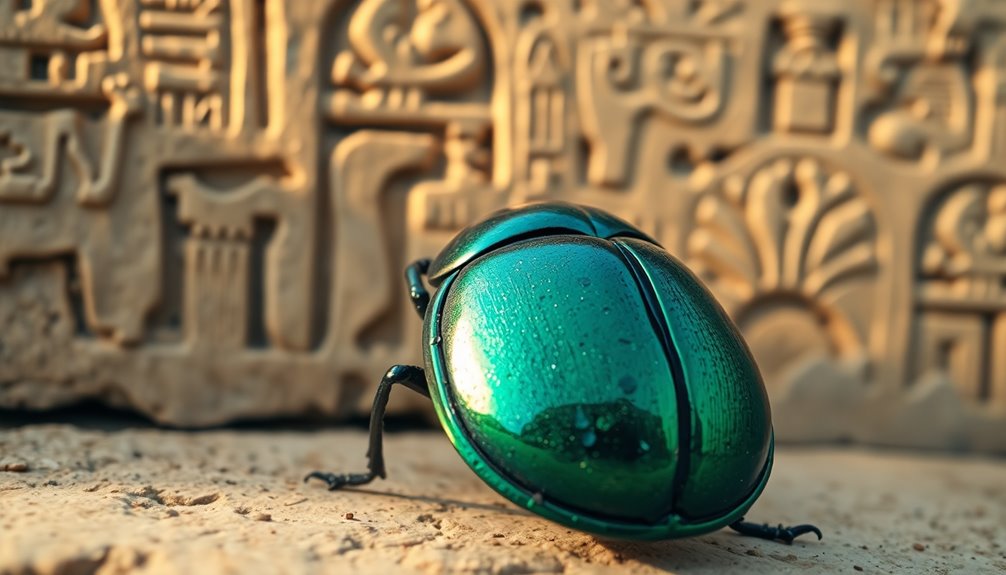
When you explore ancient Egyptian culture, you'll find that scarabs hold a remarkable historical significance. These beetles symbolize life, death, and regeneration, embodying the ancient Egyptians' deep connection to the natural cycle of existence. The scarab's association with the sun god Khepri underscores its significance; Khepri represents the daily rebirth of the sun, mirroring the Egyptians' reverence for renewal.
Evidence of scarab worship dates back to the Prehistoric Period, showing their enduring spiritual relevance long before the dynastic ages. During the Old Kingdom, scarabs emerged as significant amulets, often placed in tombs to guarantee protection and good fortune.
Heart scarabs, inscribed with spells, played a key role in funerary practices. These special scarabs were placed over the heart of the deceased, guaranteeing safe passage through the afterlife and aiding in moral judgment during the weighing of the heart ceremony.
Scarabs also served practical purposes as seals from the 12th Dynasty onward, a fundamental function in a society lacking locks. This blend of functionality and powerful symbolism makes scarabs an indispensable aspect of ancient Egyptian culture, representing the quest for eternal life and spiritual protection.
Scarab as a Protective Amulet
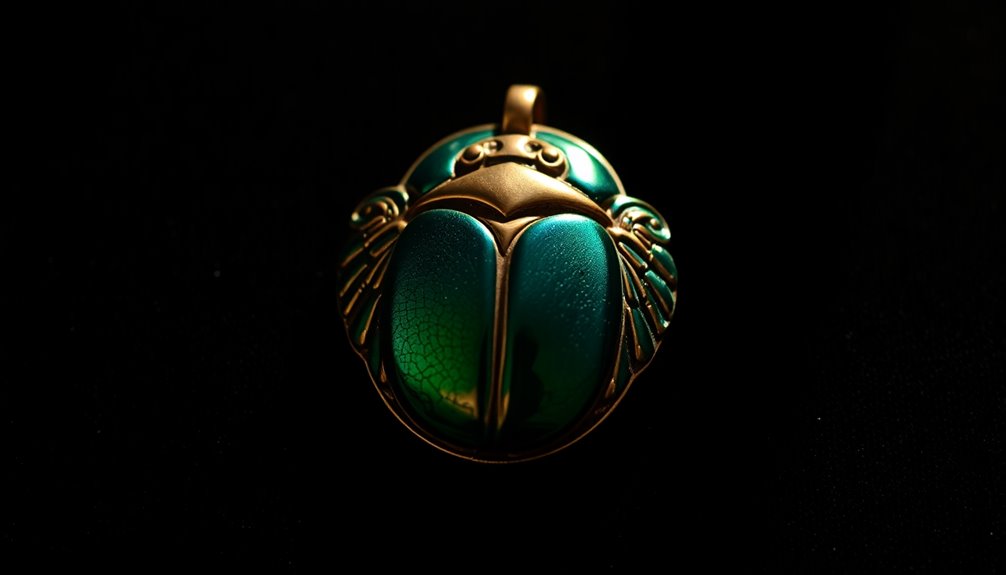
Protection was a fundamental aspect of ancient Egyptian beliefs, and the scarab amulet embodied this principle. You'd find scarabs worn widely as talismans, believed to offer powerful protection against evil forces and misfortune. Their significance as protective amulets extended beyond the elite to all social classes, making them a widely embraced symbol of safety in ancient Egypt.
To enhance their protective powers, scarab amulets were often inscribed with spells and prayers, ensuring the wearer could navigate both life and the afterlife safely. Among these amulets, the Heart Scarab stood out, larger and specifically designed to be placed on the chests of mummies. This scarab was essential in ensuring that the heart wouldn't betray the deceased during the divine judgment.
Moreover, scarabs crafted from precious materials were commonly placed in tombs or wrapped with mummies, emphasizing their importance in safeguarding the soul's journey after death.
In this way, the scarab amulet served not just as a symbol of protection, but also as a steadfast guardian against potential threats, reflecting the deep-rooted beliefs of ancient Egyptians about the afterlife and the forces that could disrupt it.
Symbol of Rebirth and Transformation
Often overlooked, the scarab beetle serves as a powerful symbol of rebirth and transformation in ancient Egyptian culture. This sacred creature, particularly associated with the sun god Khepri, rolls dung in a manner that mirrors the sun's journey across the sky, symbolizing the cyclical nature of life.
In Egyptian mythology, the scarab embodies the eternal cycle of life, death, and regeneration, reinforcing the belief in rebirth. Scarabs were more than just symbols; they were protectors of the soul. You'd often find scarab amulets buried with the deceased or worn by the living to guard against evil forces and guarantee safe passage through the afterlife.
This connection to transformation was vital for spiritual growth. The heart scarab, placed on the chests of mummies, was inscribed with spells that controlled the heart in the afterlife, emphasizing the moral judgment tied to resurrection.
Ultimately, the scarab beetle serves as a potent reminder of your potential for transformation in life. Just as the beetle undergoes its cycles, you too can embrace rebirth and renewal, echoing the timeless lessons of Egyptian mythology.
Connection to Khepri and Creation
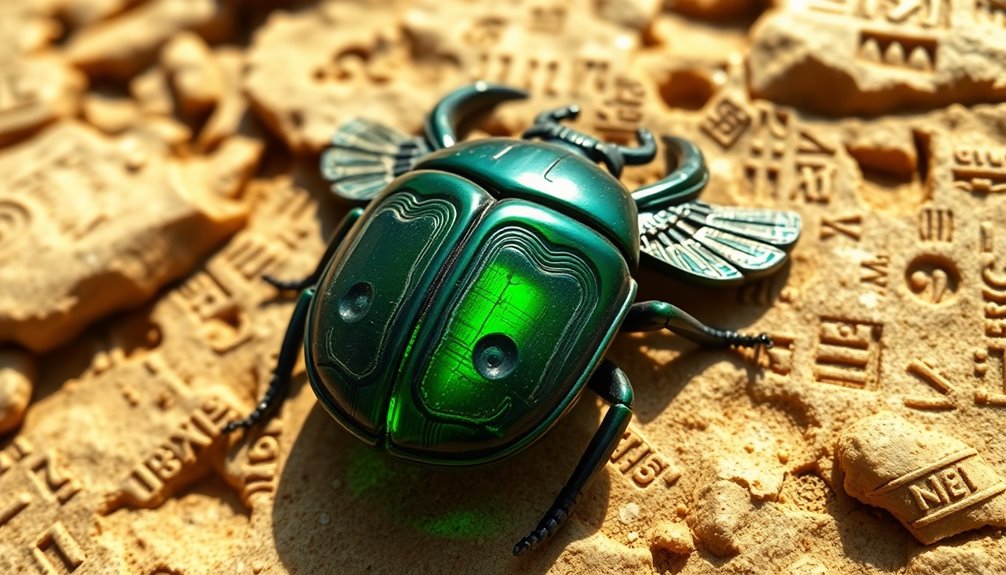
When you consider the scarab's connection to Khepri, you see how this beetle embodies the daily journey of the sun across the sky.
By rolling dung, the scarab symbolizes regeneration and the cyclical nature of life, echoing Khepri's role in creation.
This powerful link elevates the scarab's status in ancient Egyptian culture as a symbol of rebirth and divine protection.
Khepri's Daily Journey
Khepri's daily journey unfolds as a powerful metaphor for creation and rebirth in ancient Egyptian belief. As the sun god, Khepri embodies the essence of the scarab beetle, symbolizing the sun's daily rise and the eternal cycle of life.
Each morning, you can imagine Khepri rolling the sun across the sky, much like a scarab rolls dung balls, highlighting the themes of renewal and transformation.
Consider the following aspects of Khepri's journey:
- Creation: Khepri represents the act of coming into being, aligning with the scarab's transformative nature.
- Rebirth: Each sunrise signifies a new beginning, allowing you to reflect on your own cycles of life.
- Daily Life: Khepri's actions remind you of the importance of daily renewal and hope in your routine.
- Eternal Cycle: The connection between the scarab and Khepri reinforces the idea that life is a continuous loop of death and rebirth.
Additionally, Khepri's symbolism serves as a reminder of the importance of keeping memories alive through meaningful tributes in our lives.
Symbol of Regeneration
The scarab beetle stands as a potent symbol of regeneration, intimately tied to Khepri and the theme of creation in ancient Egyptian culture. You'll find that the scarab's role in rolling dung balls mirrors the sun's journey across the sky, embodying the daily rebirth that Khepri, the creation god, represents. The term "hprr," linked to the scarab, emphasizes transformation and the cyclical nature of life, reinforcing its status as a symbol of rebirth.
In ancient Egyptian culture, scarabs weren't just insects; they were powerful amulets believed to protect the deceased and guarantee a safe passage to the afterlife. By placing scarab artifacts in tombs, you invoke the essence of regeneration, reminding the soul of its journey through life and beyond.
This deep connection with rebirth solidifies the scarab as an enduring emblem of renewal, transformation, and the eternal cycle of life. Ultimately, the scarab serves as a constant reminder that life is a series of beginnings and endings, embodying the essence of regeneration and the divine influence of Khepri, the god of creation.
Scarabs in Art and Culture

Scarabs have a rich history in art, often showcased in stunning jewelry, sculptures, and intricate wall carvings that symbolize protection and rebirth.
You'll notice that their designs, made from precious materials like gold and lapis lazuli, reflect their cultural significance throughout ancient Egypt and beyond.
Today, modern fashion still draws inspiration from these ancient symbols, merging beauty with deep-rooted meaning.
Artistic Representations of Scarabs
When you explore ancient Egyptian art, you'll often come across striking representations of scarabs that serve as more than just decorative elements. These artistic representations embody deep symbolism, particularly surrounding themes of protection and rebirth.
Scarabs were meticulously crafted in various forms, showcasing the expertise of ancient artisans. Here are some key aspects of scarabs in art:
- Jewelry: Scarabs adorned necklaces and rings, believed to provide protection and good fortune.
- Sculptures: These were often placed in temples and tombs, symbolizing the deceased's journey to the afterlife.
- Wall Paintings: Scarabs appeared in intricate murals, illustrating their significance in daily life and spirituality.
- Amulets: Crafted from materials like steatite and lapis lazuli, these amulets featured detailed inscriptions for both aesthetic and magical purposes.
As you investigate these artistic forms, you'll notice how scarabs transcended ancient Egypt, influencing cultures like the Greeks and Romans.
Their enduring legacy continues to inspire modern interpretations, reminding us of the cyclical nature of life and transformation. Scarabs truly represent a timeless connection between art and deeper human beliefs.
Scarabs in Modern Fashion
Incorporating scarab motifs into modern fashion has sparked a vibrant trend that marries ancient symbolism with contemporary style. You'll find scarabs adorning jewelry, clothing, and accessories, each piece echoing the sacred beetle's rich cultural significance. Designers are increasingly inspired by the scarab, infusing collections with intricate detailing that pays homage to the artistic techniques of ancient artisans.
In modern times, these designs symbolize personal transformation and empowerment, serving as powerful reminders of resilience and regeneration. Wearing a scarab-themed piece isn't just about making a fashion statement; it's about embracing the cyclical nature of life that the scarab represents.
This resurgence reflects a broader fascination with ancient Egyptian history and spirituality, allowing you to celebrate cultural heritage through fashion. Scarabs have transcended their historical roots, becoming a stylish emblem of strength and renewal.
As you explore the world of fashion, consider the significance behind each scarab motif, and let it inspire your journey of personal transformation. The blending of ancient symbolism with contemporary aesthetics guarantees that these timeless icons remain relevant and impactful in today's style landscape.
Modern Interpretations and Influence
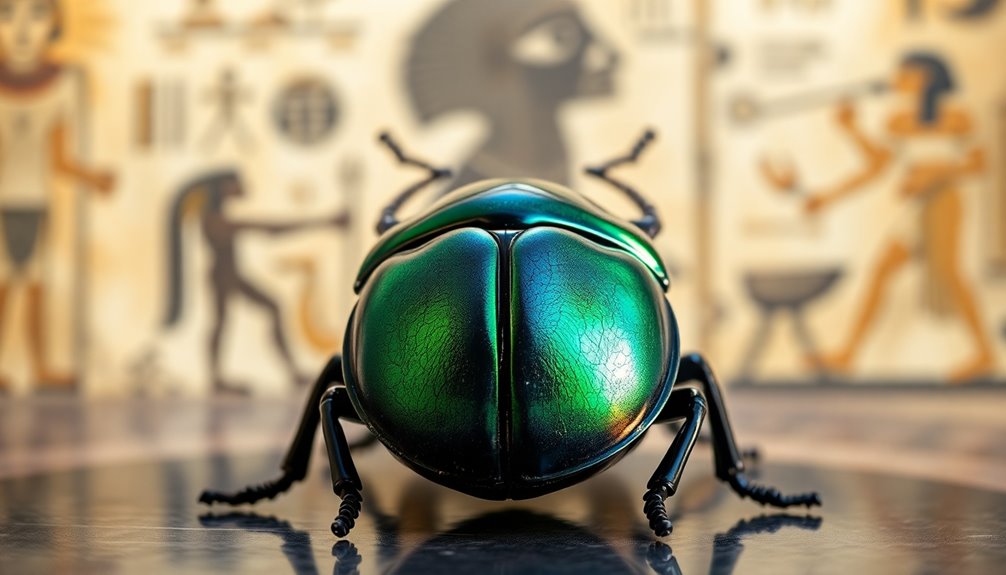
Often seen in modern culture, the scarab symbol has evolved into a powerful representation of personal growth and transformation. It encourages you to embrace change in your life, reminding you that resilience and self-discovery are critical components of your journey.
The scarab's influence is evident in various aspects of contemporary life:
- Jewelry Design: Scarab motifs blend ancient symbolism with modern aesthetics, making them trendy among fashion enthusiasts.
- Art and Tattoos: The scarab symbolizes resilience and hope, frequently appearing in tattoos and home decor that inspire personal reflection.
- Spirituality: Many self-help philosophies adopt the scarab as a symbol of empowerment and the transformative journey towards self-discovery.
- Environmental Awareness: The scarab's legacy inspires eco-conscious movements, reminding you of the importance of nurturing and protecting the environment.
Frequently Asked Questions
What Does the Scarab Symbolize?
The scarab symbolizes renewal and transformation, reflecting a deep connection to life, death, and rebirth.
You might see it as a representation of the sun's daily journey, emphasizing the cyclical nature of existence. In ancient cultures, wearing a scarab amulet could bring you protection and good luck, while heart scarabs, placed on mummies, guaranteed a safe passage to the afterlife.
What Is the Metaphor of the Scarab?
The scarab's metaphor is like a phoenix rising from the ashes, symbolizing life's continuous cycle of transformation.
When you think of the scarab, you see renewal and regeneration, as it pushes through decay to create new life.
It's a reminder that just as the scarab rolls its dung, you can navigate challenges and emerge stronger.
Embracing this metaphor encourages you to find growth in adversity and trust in the protective forces around you.
What Is the Most Powerful Egyptian Symbol?
When you think about powerful Egyptian symbols, the scarab beetle stands out. It represents eternal life, transformation, and resurrection.
You'll find scarabs used as amulets for protection in both life and the afterlife. The heart scarab, placed on the deceased during mummification, symbolizes the soul's journey.
Its significance even spread to cultures like ancient Greece and Rome, where it continued to embody protection and good luck, cementing its status as a timeless icon.
What God Does the Scarab Represent?
The scarab represents Khepri, the ancient Egyptian god of creation and the rising sun.
When you think of Khepri, envision the daily rebirth of the sun, as he rolls it across the sky. This powerful imagery reflects regeneration and the cycle of life.
In ancient practices, people often invoked Khepri's protection through scarabs, believing they'd guide the deceased in their journey to the afterlife, embodying the essence of life, death, and rebirth.
Conclusion
In exploring scarab symbolism, you uncover a profound truth: this timeless icon isn't just an ancient relic but a powerful symbol of protection and rebirth. The scarab's connection to Khepri highlights its role in creation and transformation, reminding you that change can bring new beginnings. Even today, its influence persists in art and culture, encouraging you to embrace the cycles of life. Ultimately, the scarab embodies the hidden forces that shape our journeys, urging you to recognize their significance.

